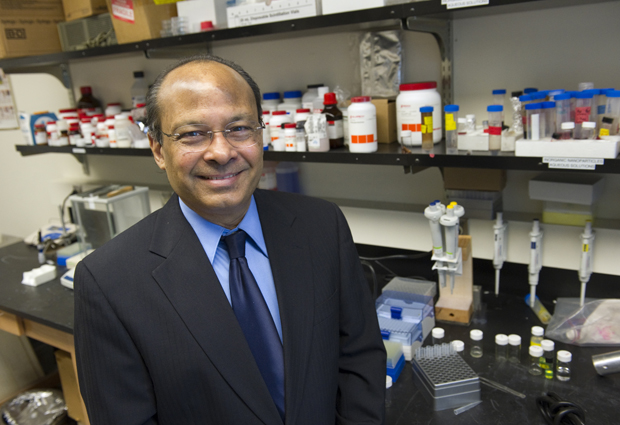Chemotherapy from the inside out

A significant number of prostate cancer patients are treated with a combination of radiation and chemotherapy, according to Sri Sridhar, Distinguished Professor of Physics in the College of Science.
While combination therapy can have a synergistic effect, the approach has drawbacks, said Sridhar’s colleague, Paul Nguyen, an assistant professor of radiation oncology at Harvard Medical School. “Both of these are limited by the collateral damage they cause to the rest of the body,” he explained.
For the last two years, Sridhar has worked with Nguyen and medical physicists Mike Makrigiorgos, Robert Cormack and Anthony D’Amico of the Dana-Farber Cancer Institute to develop a method that could make the combination therapy less toxic and possibly more effective at curing prostate cancer.
“The clinicians at Dana-Farber identified the challenges and the problems and we find the nanotechnology solutions to them,” Sridhar said. “We’re really bringing together the nanomedicines we’re developing here at Northeastern to address their key clinical challenges.”
Last month, the United States Department of Defense Prostate Cancer Research Program awarded Sridhar’s interdisciplinary group a three-year $560,000 grant to pursue this work in preclinical trials. Their proposal beat out more than 900 others for one of 60 grants focusing on prostate cancer research.
The toxic effects of traditional chemotherapy techniques force patients to wait for two to three weeks between injections, Sridhar explained. “And then the drug is only in the prostate for a short period of time.”
Radiation therapy, on the other hand, is sustained over several weeks. A commonly used radiation technique, called brachytherapy, allows doctors to implant radioactive seeds directly into the prostate, ensuring a localized deployment of the treatment. Currently, no similar technique exists for chemotherapy.
Inert plastic spacers are currently used to locate the radioactive seeds within a tumor. Sridhar’s team is designing “smart” spacers by adding nanoparticle coatings that release chemotherapy drugs directly into the tumor without infiltrating the rest of the body.
“The advantage of releasing it in the prostate,” Sridhar said, “is we can do it continuously and systematically in a sustained manner over the course of the radiation treatment.”
The new technique, called Biological In Situ Image Guided Radiation Therapy, or BIS-IGRT, developed by the Northeastern-Dana Farber team, has the potential to cause a paradigm shift in the clinical practice of chemo and radiation therapy, Sridhar said. The technique, he noted, carries no additional burden for the patient.
Nguyen has already identified a subgroup of patients that could initially benefit from the therapy.
“We have the patients in need and can generate a wish-list of what kinds of technologies we would like to have to treat our patients with,” Nguyen said. “But it takes nanotechnology dream-makers like professor Sridhar and his team to turn some of these dreams into realities that can have an immediate and real impact on patients facing aggressive cancers.”
View selected publications of Sri Sridhar in IRis, Northeastern’s digital archive.





